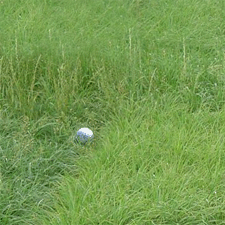During the 3rd round of last month’s HealthONE Colorado Open, defending champion Nathan Lashley’s ball found the first fairway, but unluckily came to rest in a particularly bad lie. It wound up in an area that might have been an old divot, and there was some gnarly grass around his golf ball. One blade of grass (it looked like a weed, but I have now been told that it was a ryegrass seed head) was particularly long as it had not been cut by the fairway mower in quite some time. When Nathan arrived at his golf ball he removed this growing blade of grass without even thinking–in the same manner you would remove a leaf or twig from around your ball. A fellow competitor and spectator in the group witnessed this and mentioned it to a Rules Official on course. Once this was brought to our attention we then needed to ask him about it and determine if a rules infraction had in fact occurred. Because he was already a few holes into the round we decided to address the situation in the scoring area at the end of his round before he returned his scorecard.
The rules infraction we were concerned about involved Rule 13-2 in the Rules of Golf, which states that “a player must not improve or allow to be improved his line of play.” By breaking off this piece of grass, which is considered a fixed and growing object, Nathan may very well have improved his line of play. When he arrived to the scoring the situation was addressed, but he could not remember having removed the grass which is completely understandable. When he removed the grass he was thinking about the bad lie on the first hole, his yardage to the flagstick, where the hole was is located, etc., and just removed it instinctively like a leaf. But a fellow competitor and spectator clearly saw him do this, so we were confident it had occurred. However, he hadn’t broken the rule yet– we still had to determine if the blade of grass was on his line of play.
Because it had occurred on the 1st hole, we brought the entire group out to find the location where he played his shot. After evaluating where the blade of grass was compared to where his ball lied, it was determined that it was clearly on his line of play, about six inches in front of the ball, directly between it and the hole. Prior to this situation, there have been similar rulings and precedents set. For example, in 2003 at the FBR Capital Open, Duffy Waldorf tapped down a pitch mark just in front of and to the right of his lie. Like so many Rules infractions are caught today, a television spectator saw this and called it in. After Tour officials looked at the video tape they determined that Duffy had improved his line of play and he incurred a two-stroke penalty. Eight years later at the Colorado Open, although the spectator was there (not watching TV) and the Rules Officials re-enacted the situation (lacking instant replay), the verdict was the same–we determined that Nathan had improved his line of play and he incurred a two-stroke penalty on the first hole.
As Richard Tufts reminds us in The Principles Behind the Rules of Golf, we must play the ball as it lies and the course as we find it. Clearly Mr. Lashley failed to play the course as he found it, and it cost him two-strokes and a chance to earn his second consecutive Colorado Open title.


